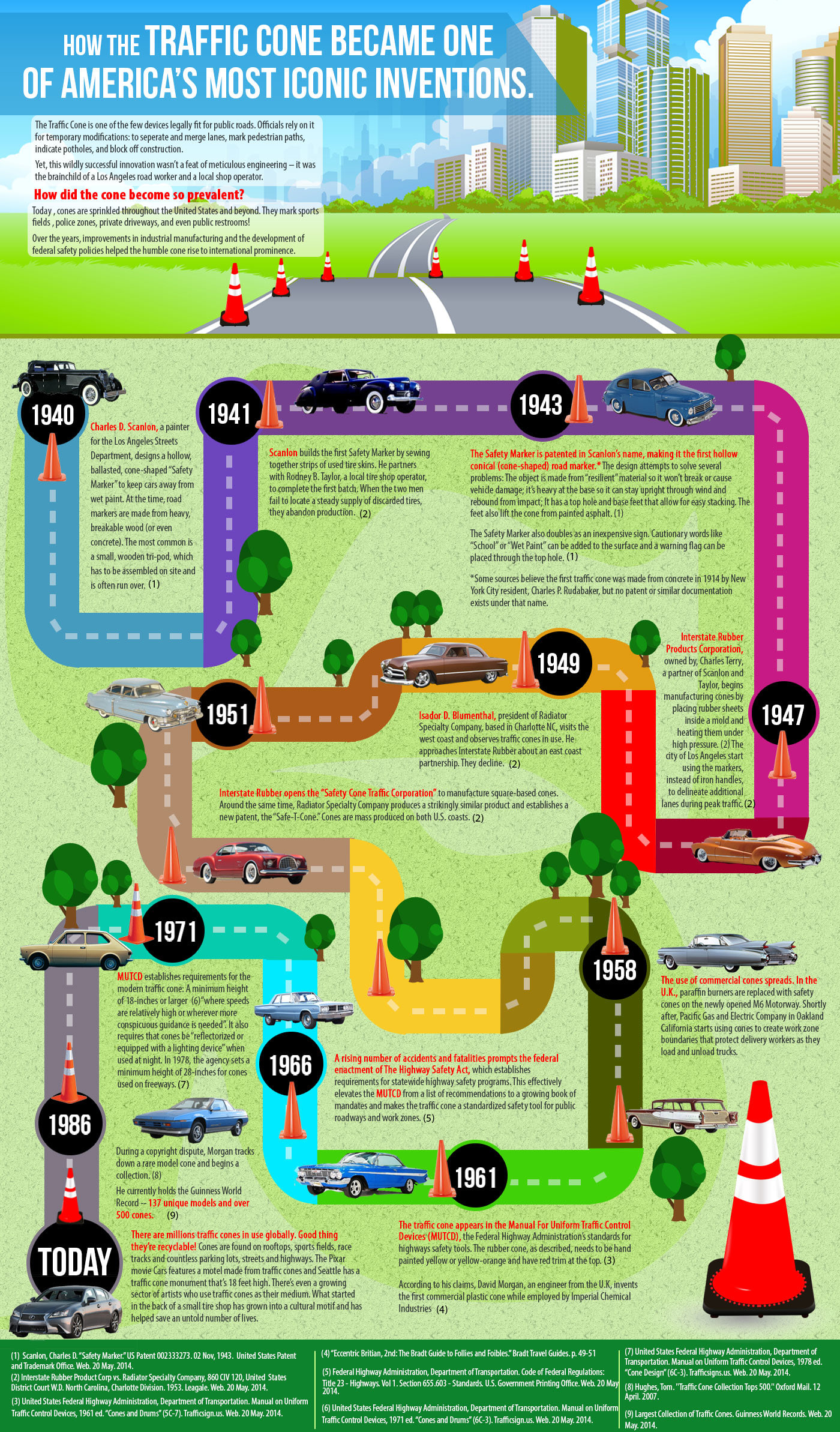1940
Charles D. Scanlon, a painter for the Los Angeles Streets Department, designs a hollow, ballasted, cone-shaped “Safety Marker” to keep cars away from wet paint. At the time, road markers are made from heavy, breakable wood (or even concrete!). The most common is a small, wooden tri-pod, which has to be assembled on site and is often run over. (1)
1941
Scanlon builds the first Safety Marker by sewing together strips of used tire skins. He partners with Rodney B. Taylor, a local tire shop operator, to complete the first batch. When the two men fail to locate a steady supply of discarded tires, they abandon production. (2)
1943
The Safety Marker is patented in Scanlon’s name, making it the first hollow conical (cone-shaped) road marker.* The design attempts to solve several problems: The object is made from “resilient” material so it won’t break or cause vehicle damage; it’s heavy at the base so it can stay upright through wind and rebound from impact; It has a top hole and base feet that allow for easy stacking. The feet also lift the cone from painted asphalt. (1)
The Safety Marker also doubles as an inexpensive sign. Cautionary words like “School” or “Wet Paint” can be added to the surface and a warning flag can be placed through the top hole. (1)
*Some sources believe the first traffic cone was made from concrete in 1914 by New York City resident, Charles P. Rudabaker, but no patent or similar documentation exists under that name.
1947
Interstate Rubber Products Corporation, owned by, Charles Terry, a partner of Scanlon and Taylor, begins manufacturing cones by placing rubber sheets inside a mold and heating them under high- pressure. (2) The city of Los Angelis start using the markers, instead of iron handles, to delineate additional lanes during peak traffic.
1949
Isador D. Blumenthal, president of Radiator Specialty Company, based in Charlotte NC, visits the west coast and observes traffic cones in use. He approaches Interstate Rubber about an east coast partnership. They decline. (2)
1951
Interstate Rubber opens the “Safety Cone Traffic Corporation” to manufacture square-based cones. Around the same time, Radiator Specialty Company produces a strikingly similar product and establishes a new patent, the “Safe-T-Cone.” Cones are mass produced on both U.S. coasts. (2)
1958
The use of commercial cones spreads. In the U.K., paraffin burners are replaced with safety cones on the newly opened M6 Motorway. Shortly after, Pacific Gas and Electric Company in Oakland California starts using cones to create work zone boundaries that protect delivery workers as they load and unload.
1961
The traffic cone appears in the Manual For Uniform Traffic Control Devices (MUTCD), the Federal Highway Administration’s standards for highways safety tools. The rubber cone, as described, needs to be hand painted yellow or yellow-orange and have red trim at the top. (3)
According to his claims, David Morgan, an engineer from the U.K, invents the first commercial plastic cone while employed by Imperial Chemical Industries (4).
1966
A rising number of accidents and fatalities prompts the federal enactment of The Highway Safety Act, which establishes requirements for statewide highway safety programs. This effectively elevates the MUTCD from a list of recommendations to a growing book of mandates and makes the traffic cone a standardized safety tool for public roadways and work zones. (5)
1971
MUTCD establishes requirements for the modern traffic cone: A minimum height of 18-inches and orange colored, “where speeds are relatively high or wherever conspicuous guidance is needed.” It also requires cones be reflective or hold a lighting device when used at night. (6) In 1978, the agency set a minimum height of 28-inches for cones used on freeways. (7)
1986
During a copyright dispute, Morgan tracks down a rare model cone and begins a collection. (8) He currently holds the Guinness World Record -- 137 unique models and over 500 cones. (9)
Today
There are millions traffic cones in use globally. Good thing they’re recyclable! Cones are found on rooftops, sports fields, race tracks and countless parking lots, streets and highways. The Pixar movie Cars features a motel made from traffic cones and Seattle has a traffic cone monument that’s 18 feet high. There’s even a growing sector of artists who use traffic cones as their medium. What started in the back of a small tire shop has grown into a cultural motif and has helped save an untold number of lives.
References
- Scanlon, Charles D. "Safety Marker." US Patent 002333273. 02 Nov, 1943. United States Patent and Trademark Office. Web. 20 May. 2014.
- Interstate Rubber Product Corp v. Radiator Specialty Company, 860 CIV 120, United States District Court W. D. North Carolina, Charlotte Division. 1953. Leagle. Web. 20 May. 2014.
- United States Federal Highway Administration, Department of Transportation. Manual on Uniform Traffic Control Devices, 1961 ed. “Cones and Drums” (5C-7). Trafficsign.us. Web. 20 May. 2014.
- “Eccentric Britain, 2nd: The Bradt Guide to Britain's Follies and Foibles.” Bradt Travel Guides. p.49-51.
- Federal Highway Administration, Department of Transportation. Code of Federal Regulations: Title 23 - Highways. vol 1. Section 655.603 - Standards. U.S. Government Printing Office. Web. 20 May. 2014.
- United States Federal Highway Administration, Department of Transportation. Manual on Uniform Traffic Control Devices, 1971 ed. “Cone Design” (6C-3). Trafficsign.us. Web. 20 May. 2014.
- United States Federal Highway Administration, Department of Transportation. Manual on Uniform Traffic Control Devices, 1978 ed. “Cone Design” (6C-3). Trafficsigns.us. Web. 20 May. 2014.
- Hughes, Tom. "Traffic Cone Collection Tops 500." Oxford Mail. 12 April. 2007.
- Largest Collection of Traffic Cones. Guinness World Records. Web. 20 May. 2014


